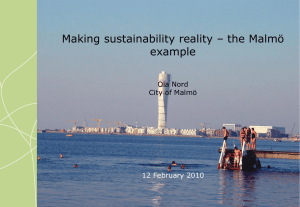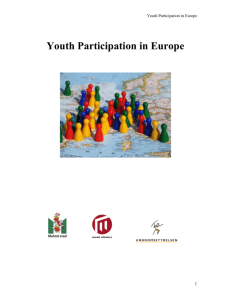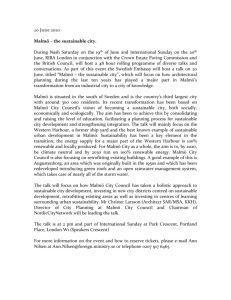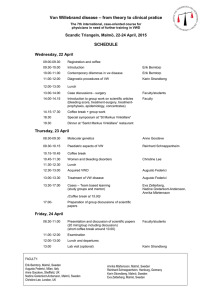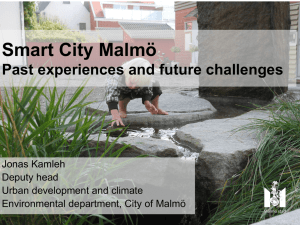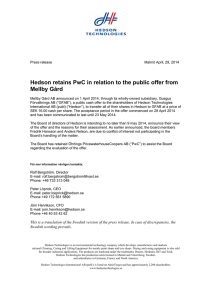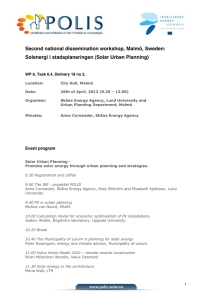What is climate change adaptation?
advertisement
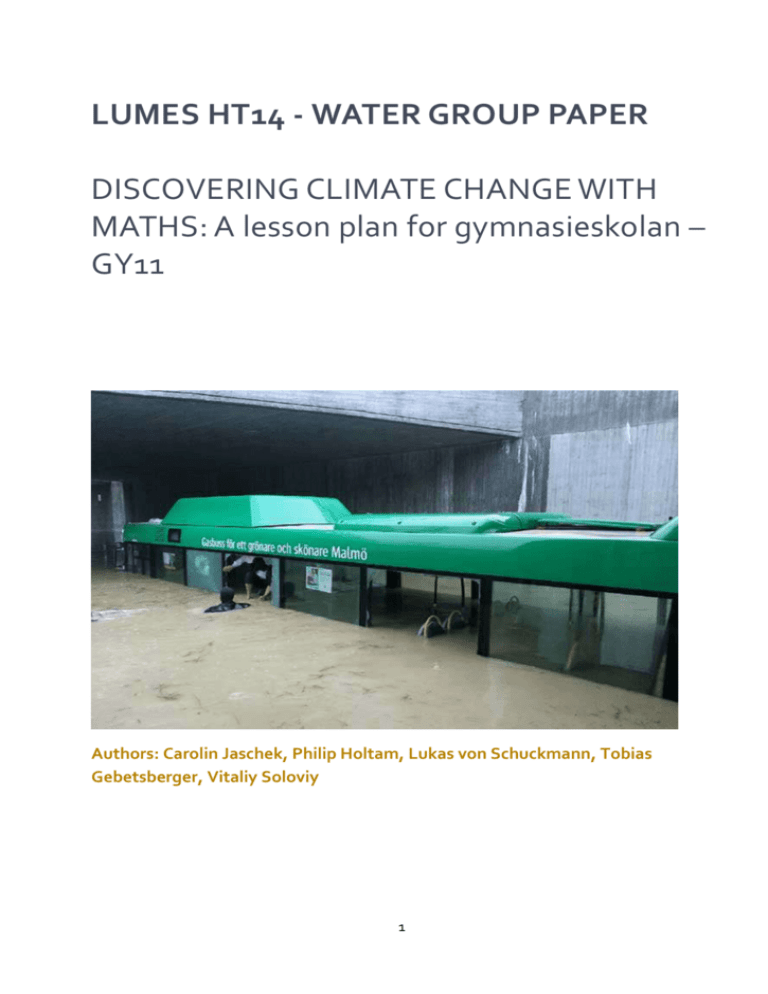
LUMES HT14 - WATER GROUP PAPER DISCOVERING CLIMATE CHANGE WITH MATHS: A lesson plan for gymnasieskolan – GY11 Authors: Carolin Jaschek, Philip Holtam, Lukas von Schuckmann, Tobias Gebetsberger, Vitaliy Soloviy 1 CONTENTS Authors: Carolin, Phil, Lukas, Tobi, Vitaliy ....................................................................................................1 Learning objectives ......................................................................................................................................3 Suggested lesson structure ..........................................................................................................................3 Lesson plan ................................................................................................................................................. 4 How did we go about it? ................................................................................ Error! Bookmark not defined. Challenges for the group work....................................................................... Error! Bookmark not defined. Links to sustainability science........................................................................ Error! Bookmark not defined. Appendix I: The Hydrological Cycle ..............................................................................................................7 Appendix IV: Maths solutions ...................................................................................................................... 8 Appendix V: Suggestion for interdisciplinary collaboration between Maths and Social Science .................. 9 2 LESSON BACKGROUND INFORMATION Learning objectives Our lesson aims to transmit knowledge and foster critical thinking in the fields of mathematics and climate change/sustainability, as well as soft skills such as group work. Therefore, we had the following learning objectives in mind: Situate global issues in the local context by linking climate change with risks to the pupils’ immediate environment, the city of Malmö. Explore the challenge of providing potable water to people in the context of an altered and uncertain hydrological cycle. Improve understanding of climate change adaptation challenges from different social viewpoints, particularly in terms of flood risk and proactive responses to it. Develop understanding of how mathematics is relevant to sustainability issues on the example of climate change, and that it can help to solve real world problems. Practice different mathematical skills and their application, i.e. differentiation, integration, binomial probability calculations. Improve English vocabulary and fluency, especially applied to problem solving, sustainability issues and mathematics. Suggested lesson structure # Time Forum Content Material Sources 1 10 Hydrological cycle / basic facts about water. Impact of urban development on the hydrological cycle. Capacity of water drainage systems. Flooding as a problem. Working sheet, Appendices I, II, III DRBC, n.d.; Parkinson, 2005; SSWM, 2012 Stahre, 2008; Thorolfsson, 2012; UNESCO, n.d. 2 5 Didactic teaching, individual and group work Didactic teaching 3 30 - 45 Small groups Main Task: Applying student’s mathematical knowledge to tackle concrete problems associated with climate change. Mathematical exercise: Flooding scenario for a short term precipitation. In the end, the solution will be discussed. Provided in lesson plan Hallegatte et al., 2010 Zhou et al., 2013 4 10 Group reflection / discussion Wrap-up: pupils are given food for thought - Malmö Stad, 2012 51 45 Group exercise From Math to Social Science: Decisionmaking exercise on cooperation of societal actors for long-term proactive measures and immediate action in case of extreme event Suggestions provided in Appendix IV - 1 Intro: Extreme weather events and sea level rise. Link between drinking water and floods. Implications for the pupils’ world / Malmö. Optional 3 Bengtsson & Milloti, 2010; Malmö Stad, 2012; Stocker et al., 2013: The Local, 2014 Lesson plan Part 1: Warm up Hydrological cycle / basic facts about water. Impact of urban development on the hydrological cycle. Capacity of water drainage systems. Flooding as a problem. The lesson starts with the recap of the hydrological cycle (Appendix I). After a short introduction from the teacher’s side, the pupils will be handed a worksheet with blank fields to fill out. Flooding in Urban Areas The hydrological cycle is affected by urbanization (Appendices II and III). In cities most of the ground is impermeable due to the high number of buildings, pavements, roads and cars. And these objects have consequences for water drainage systems. High urban density leads to soil compaction which reduces infiltration capacity, as well as to loss of natural retention capacity in sites such as wetlands. Further consequences are reduced surface storage capacity and decreased evapotranspiration. Prevention and response Drainage systems are an essential feature of urban planning. Some of these systems will be as old as the buildings in the city and will have served the city for centuries, whilst in newer neighbourhoods they are likely to have been installed with state-of-the-art materials and design knowledge. Drainage systems have a maximum water transportation capacity (the rate at which water can be dispersed) and a maximum water storage capacity (the amount it can hold within a location). The overloading of drainage systems leads to flooding, posing serious risks to human safety, public infrastructure and private property. During flood events, there can be a risk of contamination of the run-off water through heavy metals, oil or sewage. Providing drinking water to people’s homes becomes an even bigger challenge when an area is submerged, especially if this is nearby to drinking water storage facilities. The far reaching range of impacts means that it is essential for agencies from many areas to communicate and collaborate, in order to provide an integrated response to the risk. Part 2: Introduction Sea level rise and extreme weather events like heavy precipitation. Implications of climate change for the pupils’ world / Malmö. Link between drinking water and floods. Strategies for climate change adaptation. As a low-lying coastal town with many canals and rivers, the city of Malmö faces big challenges managing water flow. In the long term, there is the threat of sea level rise due to climate change: as the global temperature increases, the water molecules move more quickly, because they need more space, causing the volume of the water to increase. Additionally, the overall water volume in the oceans is increasing due to the melting of arctic ice. As a consequence we can expect a global sea level rise of 0.26 - 0.98 m by the end of the century (Stocker et al., 2013, p. 25). In Malmö, sea levels are expected to rise by 0.22 - 0.66 m by 2100 (Malmö Stad, 2012, p. 18). With the onset of climate change we can also expect that extreme weather events such as storms to be likely to happen with more frequency, intensity and variability. Because warmer air is able to hold more water, heavier rainfall is anticipated. For the city of Malmö, these changes in a global climate can cause problems of storm downpours leading to flash flooding. As a recent example, on the 30th and 31st of Au- 4 gust (2014) 100 millimetres of rain fell in just 36 hours, double the amount that normally falls over the whole of August (The Local, 2014). As of 2010, the highest recorded rainfall in Malmö over a 10-min period was 21mm and the highest recorded rainfall over 30min period was 41mm (Bengtsson & Milloti, 2010). What is climate change adaptation? Malmö’s authorities are implementing a Climate Adaptation Strategy to prepare the people and city’s infrastructure for the onset of climate change. “Climate change adaptation means that contrary to reducing greenhouse gas emissions, focus is instead on introducing measures that either alleviate or prevent the effects of climate change or derive some benefit from possibilities it might bring” (Malmö Stad, 2012, p. 4). The strategy’s main aim is to reduce the impact of the threats of sea level rise, extreme precipitation and heat waves (Malmö Stad, 2012). One way this is being done is by increasing the amount of vegetation in low-lying areas and river banks, which can absorb collected water whilst also serving the purpose of cooling the city during hot spells. Furthermore, the municipality is working on protecting sites that are prone to flooding such as tunnel entrances, the water and sewage system and underground car parks. Key infrastructure elements such as electricity and telecommunication plants are also prioritized. A key component of the Climate Adaptation Strategy is the importance of collaboration and communication between relevant agencies (such as the Real Estate Office, Social Resource Department, Environment Department, Water and Waste municipality Authority and so on). Alongside all the measures implemented by the municipality, a resilient city also needs its citizens to act responsibly within the community, which means active contribution to city planning and development, especially on the neighbourhood level; e.g. the Building-Living Dialogue Project for the Western Harbour (Malmö Stad, 2012, p.10; for more examples see, p. 25-26). Part 3: Main part – Mathematics! Applying students’ mathematical knowledge to tackle concrete problems associated with climate change. Mathematical exercise: flooding scenario for a short term precipitation. In the end, the solution will be discussed. We need mathematics in real life. This exercise will illustrate how pupils can apply maths in the context of climate change occurring in their direct environment. 1) A big storm is threatening Malmö over the upcoming weekend. The Swedish Meteorological Institute has predicted heavy rainfall for Saturday and Sunday, which can be described with the following function (t = time in hours, f(t) = rainfall in 0.1 mm): 1 f(t) = − 2 ∗ (𝑡 − 6)2 + 18 1a) For how long is it raining? 1b) How many litres of water are falling on one square metre in total? (note: mm = l ) m2 1c) Construction workers at buildings next to the Turning Torso Tower forgot to cover an empty container. How high would the water be standing at the end of the rain period? 5 2) There are two systems in place which can mitigate a flood in the city, which are the sewage system and the absorption capability of the environment (plant uptake, water uptake of the soil, etc.). The mitigation systems of the city are able to transport 0.01 m3 water per hour and square metre. 2a) By how much are the mitigation systems able to reduce the flood? 2b) How high is the water now? 3) Because of significant damages caused in the flood, the mayor wants to predict the probability that such a heavy rain event will happen again. After some research, she finds out that the flood was close to what is called a 100-year-event (in the case of the Öresund region this corresponds to a water level of 1.5 meters above sea level (Hallegatte et al., 2010)). The expected value of such an event is once in 100 years. 3a) Because the mayor is very concerned about the future of the city and her children and future grandchildren, she wants to know what the actual probability is for such an event to occur at least once again within the next 100 years. 3b) Just after having calculated the probability, she remembers that very recently the new IPCC report was released, which indicates that the frequency of those 100-years-events is likely to increase by 40% within the next 100 years (Arnbjerg, 2012). How much more likely will one or more 100-years-events occur in the year 2114 compared to today? Solutions are provided in Appendix IV. Part 4: Group reflection and discussion Wrap-up: pupils are given food for thought. After solving problems in groups and discussing solutions with the teacher, the class is invited to reflect on the outcomes of their calculations. Suggested questions for discussion: Is it important to prepare for 100-year events and what might be the costs of inaction? Did students personally feel any effect of climate change on their life or how the city operates? How do they expect climate change to influence their life in the future? (see for ideas: Malmö Stad 2012, p. 11) If they were a mayor, how might this data help them in adaptation measures (the teacher can provide examples from Climate Adaptation Strategy for Malmö (Malmö Stad, 2012, p. 13-25)). What would pupils do, if an extreme weather event was to happen in six months: individually, at home, what would they expect from the community and how would they contribute? Part 5: Optional – Decision-making exercise From Maths to Social Science: decision-making exercise on cooperation of societal actors for long-term proactive measures and immediate action in case of an extreme event. The exercise is optional and touches on the implications of the lesson so far. The idea here is to bridge two disciplines for deeper inquiry into the situation and recognize the complexity of it. We believe that mathematical conclusions provide a good support for decision-makers, but should be complementary to other ways of knowing and sources for deciding. The draft idea is provided in Appendix V. 6 APPENDICIES Appendix I: The Hydrological Cycle Appendix II: Effects of urbanization on urban stormwater run offs Source: SSWM, 2012. Source: Delaware River Basin Commission. http://www.state.nj.us Source: based on Butler & Davis, 2004, in Parkison, 2005: 5 Appendix III: Natural, the urban and a more sustainable urban water cycle in comparison http://www.sswm.info/category/implementation-tools/wastewatercollection/hardware/surface-runoff/stormwater-management 7 Appendix IV: Maths solutions 1a) 12 hours Either graphical: f(t) =0 => t=0 v t=12 1 2 or calculate: f(t) = 0 = − ∗ (𝑡 − 6)2 + 18 __________________ 1b) Integration 1 1 𝑓(𝑡) = − 2 ∗ (𝑡 − 6)2 + 18 = − 2 ∗ 𝑡 2 + 6𝑡 𝐹(𝑡) − 1 6 𝑡 3 + 3 𝑡 2 -> integrate from 0 to 12 => 144 [0.1 mm] = 1440 mm ∗ = 1440 dm3 m2 = 1440 1m 1000 mm = 1.44 m = 1.44 m3 m2 1000 dm3 ) 1 m3 ∗ ( l m2 __________________ 1c) The water would be standing 1440 mm = 1.44 metres high in the container. __________________ 2a) 𝑔(𝑡) = 10 𝑙 ℎ∗ 𝑚2 -> integrate 𝑙 𝐺(𝑡) = 10 ℎ∗ 𝑚2 ∗ 𝑡 , for t=12 => G(12) = 120 𝑙 𝑚2 __________________ 2b) F (12) - G (12) = 1100 mm The flood is 1.1 metres high. __________________ 3a) Binomial Function: 𝑃 (𝑥 ≥ 𝑟) = (𝑛𝑟) ∗ 𝑝𝑟 ∗ (1 − 𝑝)𝑛−𝑟 , for n=100, r=1, p=0.01 P = 0.63 = 63 % __________________ 3b) p=0.014 P = 0.76 = 76 % 8 Appendix V: Suggestion for interdisciplinary collaboration between Maths and Social Science To link this class with real-life decision-making, we highly recommend combining it with a special lesson in social sciences class. A brief outline is provided below. At the town-hall meeting for climate change adaptation in Malmö, a mayor (teacher) talks about challenges related to climate change (link with the maths class), about the work done by Malmö municipality and the planned measures (see Malmö Stad, 2012, p. 26 for a list of them). He/she also says that though the municipality is sure that each of the measures is necessary, they need public participation to properly allocate the available budget. Stakeholder roles are assigned to students in groups (see Malmö Stad, 2012, p. 13 for actual stakeholders involved, but it is also advised to include NGOs and industry for learning purposes), each with a unique blend of perspectives: hard-to-soft path, personal/group concerns, care for social inclusion or environmental justice etc. Each role is explained on a sheet of paper with 1-2 paragraphs: what is the role about, what they care for and what might be the measures they would be interested in. Within their groups, students can discuss the list of measures (simple version: suggest the measures they would work with, more complicated: choose from a list) and then the group representative joins the town hall meeting and defends their point of view on the issue. This would be followed by the discussion involving the whole class about presented decisions, e.g.: Are these long-term/short-term, hard/soft solutions we are moving towards? Would the decisions benefit the whole city or only part of it? Would the benefits be distributed fairly across neighbourhoods? Finally, each student would vote on his / her three top solutions, giving scores from 1 to 3. The winners will be calculated based on the total score. Finally, the class can reflect on the issue of decision-making in times of uncertainty and urgency of climate change. 9 10
